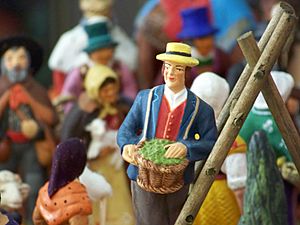Santon facts for kids
A santon (which means "little saint" in French) is a small, colorful figurine made from baked clay. These special figures come from a region in France called Provence. They are carefully painted by hand.
Santons are often used in nativity scenes, which show the birth of Jesus. You'll see figures like the Holy Family (Mary, Joseph, and baby Jesus) and the Three Wise Men. But santons also show everyday people from 19th-century French villages. Imagine a person selling chestnuts, a fish seller, or even someone sharpening scissors! These figures help bring the village life of the past to your home.
What Are Santons?
Santons are small statues, usually just a few inches tall. They are made from terra cotta, which is a type of clay that has been baked until it's hard. This makes them strong and long-lasting. Each santon is unique because it's painted by hand with great care.
These figurines are not just for Christmas. They tell stories about the history and culture of Provence. They show how people lived and worked many years ago.
A Look Back: Santons' History
Santons first became popular during the French Revolution in the late 1700s. During this time, big public nativity scenes were not allowed. People still wanted to celebrate Christmas and remember the story of Jesus' birth. So, they started making small, secret nativity scenes in their homes.
This is how the idea of santons began. People used simple materials like breadcrumbs or paper to make tiny figures. Over time, they started using clay, and the craft grew. It was a way for families to keep their traditions alive, even when things were difficult.
Making Santons Today
Making santons is often a family tradition. Parents teach their children how to mold the clay, bake it, and paint the tiny details. It takes a lot of skill and patience to create each little character.
Santon makers are called santonniers. They work hard all year to create new figures. When the Christmas season arrives, these artists gather in places like Marseille, a big city in Provence. They set up markets where people can see and buy their beautiful santons. It's a wonderful way to find a special piece of French history and art.


